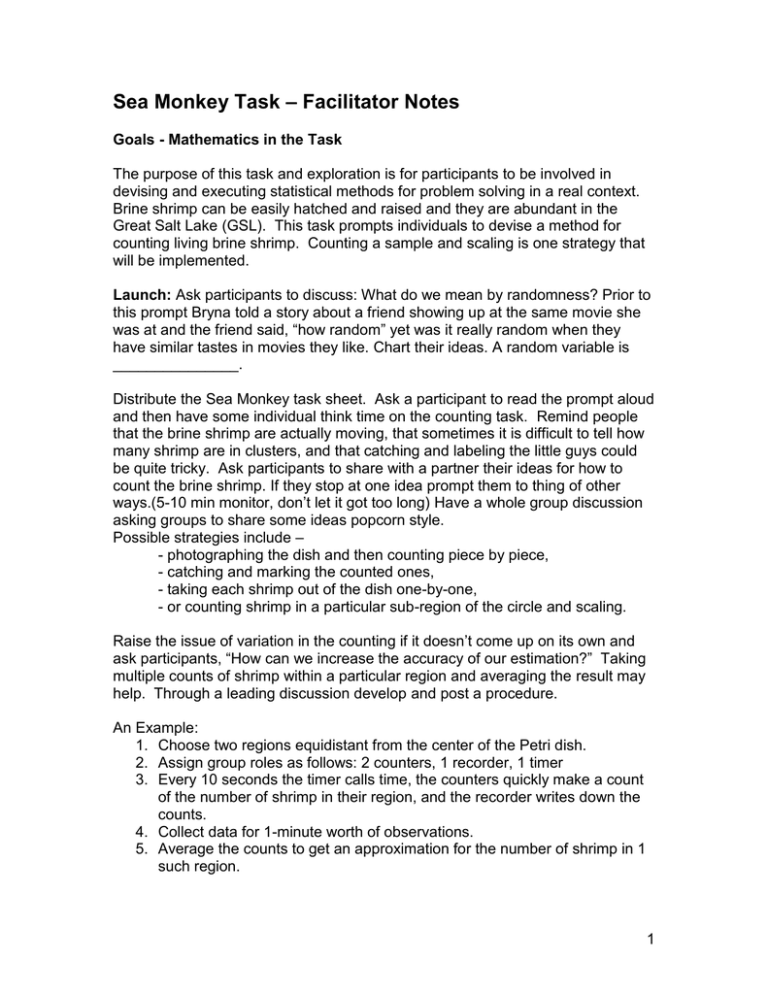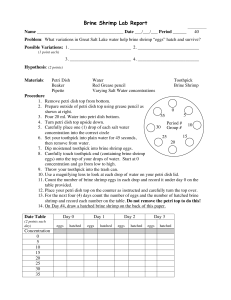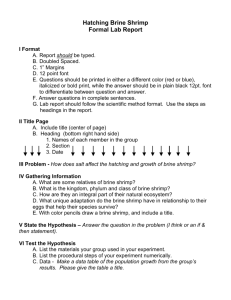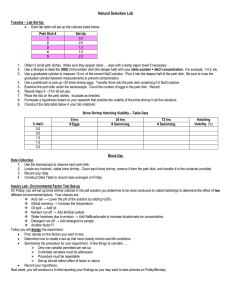Facilitator Notes for Sea Monkey Task
advertisement

Sea Monkey Task – Facilitator Notes Goals - Mathematics in the Task The purpose of this task and exploration is for participants to be involved in devising and executing statistical methods for problem solving in a real context. Brine shrimp can be easily hatched and raised and they are abundant in the Great Salt Lake (GSL). This task prompts individuals to devise a method for counting living brine shrimp. Counting a sample and scaling is one strategy that will be implemented. Launch: Ask participants to discuss: What do we mean by randomness? Prior to this prompt Bryna told a story about a friend showing up at the same movie she was at and the friend said, “how random” yet was it really random when they have similar tastes in movies they like. Chart their ideas. A random variable is _______________. Distribute the Sea Monkey task sheet. Ask a participant to read the prompt aloud and then have some individual think time on the counting task. Remind people that the brine shrimp are actually moving, that sometimes it is difficult to tell how many shrimp are in clusters, and that catching and labeling the little guys could be quite tricky. Ask participants to share with a partner their ideas for how to count the brine shrimp. If they stop at one idea prompt them to thing of other ways.(5-10 min monitor, don’t let it got too long) Have a whole group discussion asking groups to share some ideas popcorn style. Possible strategies include – - photographing the dish and then counting piece by piece, - catching and marking the counted ones, - taking each shrimp out of the dish one-by-one, - or counting shrimp in a particular sub-region of the circle and scaling. Raise the issue of variation in the counting if it doesn’t come up on its own and ask participants, “How can we increase the accuracy of our estimation?” Taking multiple counts of shrimp within a particular region and averaging the result may help. Through a leading discussion develop and post a procedure. An Example: 1. Choose two regions equidistant from the center of the Petri dish. 2. Assign group roles as follows: 2 counters, 1 recorder, 1 timer 3. Every 10 seconds the timer calls time, the counters quickly make a count of the number of shrimp in their region, and the recorder writes down the counts. 4. Collect data for 1-minute worth of observations. 5. Average the counts to get an approximation for the number of shrimp in 1 such region. 1 6. Compute the appropriate scale factor to scale the area of the chosen region to the area of the entire dish. 7. Multiply the average by the scale factor. Discuss this method with the participants and what is important for this method to work. (The shrimp should be roughly uniformly distributed in the dish.) Explore: Give participants time to implement the counting method they devised and the method above with a Petri dish and some real brine shrimp. Alternative methods may include photographing and counting, using a smaller portion of a square grid sheet rather than the polar graphing paper provided, etc… They should fill their Petri dish with a small amount of the GSL water and then use a pipette to take a bunch of brine shrimp and put them in their dish. Each group should then proceed with the counting procedure. Supplies needed for each group: Stopwatch Data collection sheet Markers A small plastic Petri dish A plastic pipette or eye-dropper with a .4mm opening using scissors to cut the tip if necessary (see below) A coffee stirrer Circulate and monitor the work progress of individual groups. Ask each person to record important information in their procedure and their final resulting estimation in their composition book. 2 Discuss: Ask participants for a summary of what they think was important about the procedure. What did you attend to when counting your sea monkeys and how do you know your estimation is reasonably accurate? In the context of predicting the sea monkey population in a Petri dish, how can we use statistical methods to make estimates? Participants will potentially: surface ideas such as . . . o o o o o o invent strategies to . . . o o random sample (what pieces did you use, did the sea monkeys move in the same direction?) vs. representative sample Mean, median, mode for different samples Number of samples taken area of samples same size proportionality (to project for the whole Petri dish) estimation of total population and error in the estimation make estimation of the overall quantity within a whole geometric region based on samples from a sub region determine amount of error in the estimation create representations that . . . o o o facilitate the collection and recording data possibly through tables Connect the chosen geometrical regions to the entire Petri dish using fractions or geometric diagrams Create an equation of proportional (a proportion) 3







